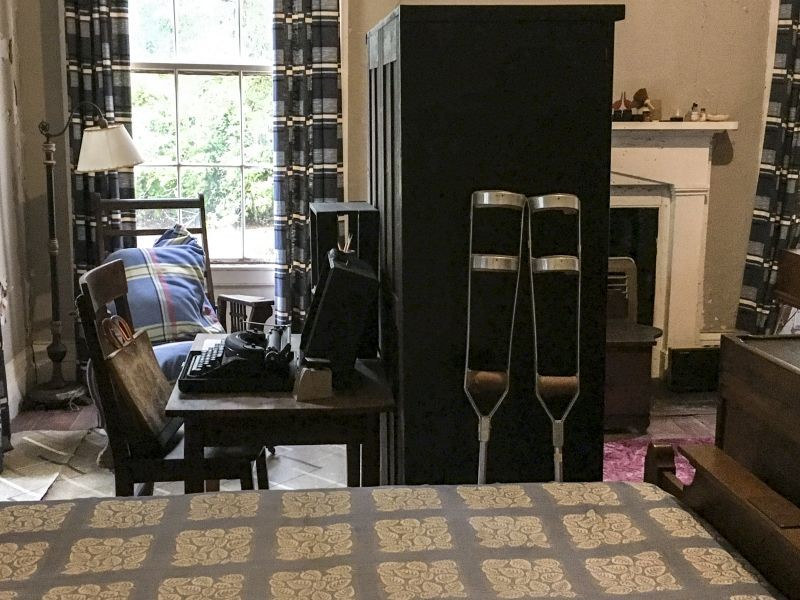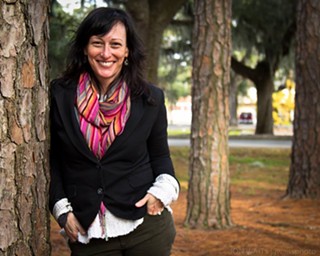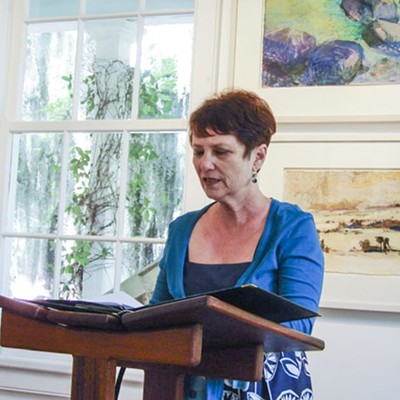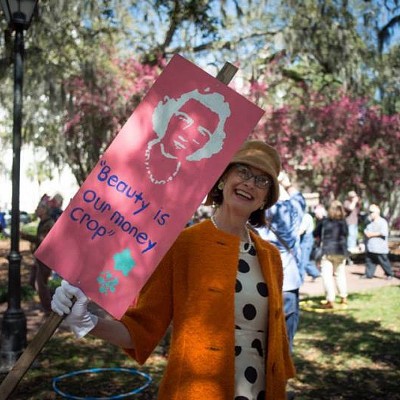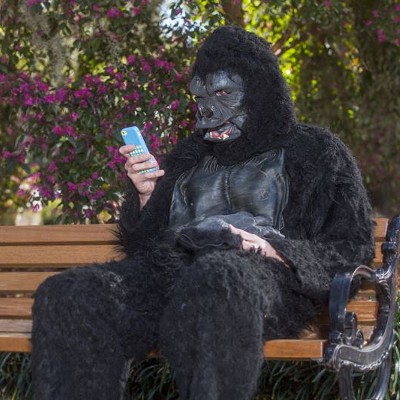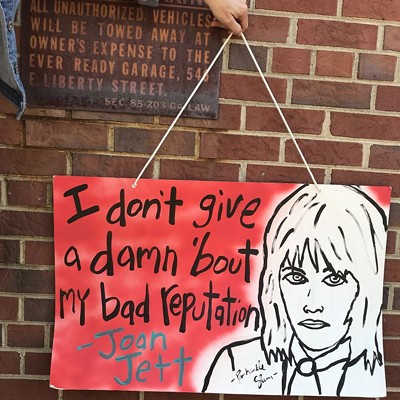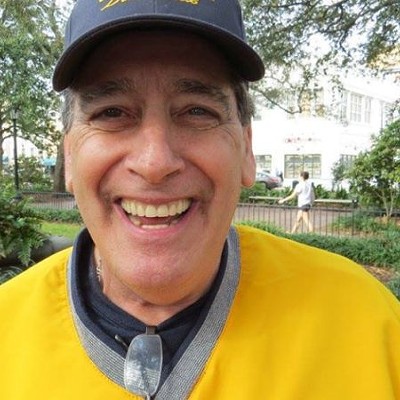THE road to Milledgeville was probably paved with the best of intentions, but barreling down Hwy 441 in an ancient Mercedes during a nasty rainstorm brought out every hellish pothole.
We had already crossed half the state, and with 60 miles left to go, the last leg of this day trip appeared to be leading to perdition.
I mean, if the priest in the backseat is nervous, you know it’s a doozy.
“Do you think we ought to pull over and wait it out for a bit?” murmured Bishop Kevin Boland in his lilting Irish accent.
I peered over the steering wheel into the steel wool of the sky, pulsing with thin, blue lines of lightning. Sheets of water slapped the windshield. Next to me, writer Beverley Willett gripped the handle above the passenger seat.
We were scheduled to arrive at 11am sharp at Andalusia Farm to meet up with our fellow board members of the Flannery O’Connor Childhood Home, and what can I say, I inherited my bubbe’s peeve for punctuality. Besides, Beverly is also a former attorney, and with the head of the Catholic Diocese of Savannah in the car, I figured Satan couldn’t wait to get far behind us.
“I think we can make it,” I said, as Old Gold’s chassis hit another puddle.
Frankly, a brimstone sinkhole could’ve opened up and I would’ve sailed around it, I was so thrilled to finally make the pilgrimage to Andalusia, the adult home of Flannery O’Connor. I’ve been on the board of the Childhood Home on Lafayette Square for a couple of years now, contributing what I can to its mission of preserving and promoting the house museum where Southern culture’s gimlet-eyed scribe spent her formative years.
Last fall, when the board’s unofficial spirit booster Meredith Grey suggested a group retreat to the 544-acre dairy farm where our own “pigeon-toed child with a receding chin and a you-leave-me-alone-or-I’ll-bite-you complex” wrote many of her famously dark stories, I volunteered to chauffeur, not knowing I’d be piloting through the devil’s weather.
The storm must’ve been impressed with us because it receded right at the outskirts of town, and we crunched up the long driveway only a few minutes late, wiping our feet carefully before entering the white two-story house.
On the yawning front porch, we joined Meredith, board member emeritus Francis Allen, Mark Taylor—who rents the Childhood Home’s garden apartment, lucky duck—and Helen Turnage, the board’s sole member from Augusta and a distant cousin of the O’Connor family.
The Savannah-Flannery contingency was greeted by Elizabeth Wylie, Executive Director of the Flannery O’Connor-Andalusia Foundation, which isn’t a foundation at all but a nonprofit struggling to stay afloat.
Elizabeth filled us in on the challenges and charms of our sister site, from fundraising woes and family entanglements to its melon-hued bedroom-cum-gallery space and the annual October bluegrass festival on the gorgeous grounds.
“We’re using contemporary art to activate these historic spaces and keep them alive,” she explained, describing the diversity and internationality of Flannery fans who come to pay homage to their literary hero.
A good four miles outside Milledgeville proper, Andalusia was only reachable “by bus or buzzard” back in 1959 when O’Connor moved in with her mother, thinking it would be a temporary arrangement.
Instead, she found herself hostage to her deteriorating health, writing in the bottom floor bedroom and tending to her flock of ungrateful peafowl. (“Over the years their attitude toward me has not grown more generous,” she lamented in a 1961 essay.)
Though she had a social life in Milledgeville and entertained with the martini set displayed on top of the Hotpoint fridge bought with her windfall selling the TV rights for “The Life You Save May Be Your Own,” her isolation from the New York literary scene she longed to be a part of still feels palpable in the tidy, tiny kitchen.
We’ll never know if the serene view of the pond from her window inspired her, but I think it’s safe to presume the barn out back sure did, its tall ladder and hayloft looking mighty similar to the description of the one where that good-fer-nuthin’ bible salesman stole Hulga’s fake leg in “Good Country People.”
The recalcitrant peacock in the pen out back also seemed to channel her wearied presence, refusing to show off his plumage.
But it’s the bedroom that really got me. Cordoned off by rope and seemingly untouched since she died in 1964 at the age of 39 from lupus, the corner space brings FOC’s life here into full relief all at once: The typewriter, grotesque in its size and irrelevance, sits on her “large ugly brown desk,” facing away from the crucifix on the paint-peeling wall. The stack of Bibles next to the bed, the bedspread stitched by her mother’s hands. The hated crutches leaning against the wardrobe.
This is the homey hermitage where Southern lit’s grande dame wrote and prayed, the space still electric with demons wrestled and art created. It was once a place of solitude; now it is a shrine.
The room’s stark vulnerability reminded me of what a tragedy it is to have lost Flannery O’Connor so early. What light would her voice have cast upon the South and beyond if she’d been around for the last fifty years? How would her writing have changed? What would she have said of today’s hypocrisies, society’s ugliness spilled over?
I really have no idea; I’m hardly a scholar of O’Connor. I read “A Good Man Is Hard to Find” my freshman year of college and was very disappointed that it contained no hot scenes at all. Wise Blood is not exactly light reading, either. I do keep The Complete Stories on my night stand, flipping through it willy nilly, reading certain ones again and again (“A Temple of the Holy Ghost” is my favorite) though my experience is that a diet too rich in O’Connor can cause misanthropic side effects.
Yet I’ve become a dedicated Flannery freak since living in Savannah, first through the annual birthday parade gathering that is both ridiculous and reverent, then through the marvelous, varied group of people who steward The Childhood Home, where someone begins every board meeting by reading a selection from the collection of her profoundly personal thoughts, A Prayer Journal.
While her literary contributions are legendary, what continues to resonate for me is her devotion—to her craft, to her truth, to her faith.
“It will be a life struggle with no consummation,” she laments on the loneliness of the writer’s life. “...I want to be the best artist it is possible to be, under God.”
Some see paradox in the brutality of Flannery O’Connor’s stories and her Catholic fealty; I can only imagine the inner turmoil that came before the words, and the spiritual sacrifices offered at the tiny altar in her high-ceilinged room.
I do believe it takes great faith to make art, and it has long been a suspicion of mine that the deeply devout of this world—the Tibetan monks chanting deep within the mountains, the cloistered nuns thumbing their rosaries, the everyday saints who pray purely and without judgment—are what have been holding it all up all along.
After our visit to Andalusia and a delicious lunch at downtown Milledgeville’s Metropolis Café, we walked over to Memory Hill Cemetery, where Mary Flannery O’Connor is buried with her parents. The sun shone as Bishop Boland said a prayer over her gravestone, then Beverly and I continued on to the Sacred Heart Church where the conflicted writer came to town to worship, a plaque bearing her name in the sanctuary. Here I also felt the presence of her monumental faith in the face of poor health and dreams fizzled, the kind that transcends religion to become grace.
Before we headed on to Augusta, where Helen would host us for the night, Bishop Boland presented me with my own copy of A Prayer Journal from Andalusia’s gift shop, a thank you for the ride, bumpy as it was.
I’ll never know if his prayers in the backseat are what got us there safely, but who I am to doubt?

